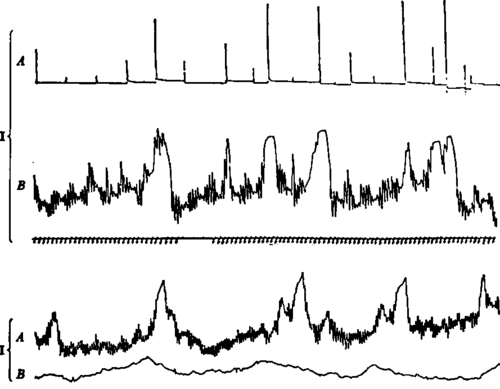I. Gastric Tonus And Hunger Contractions Increase Reflex Excitability Of Central Nervous System
Description
This section is from the book "The Control Of Hunger In Health And Disease", by Anton Julius Carlson. Also available from Amazon: The Control of Hunger in Health and Disease.
I. Gastric Tonus And Hunger Contractions Increase Reflex Excitability Of Central Nervous System
This is readily made out by recording the amplitude of the knee jerk (or any other motor reflex) parallel with the graphic recording of the gastric contractions. Such records show" without exception a marked increase in the reflex excitability of the spinal cord simultaneously with the strong hunger contractions of the empty -stomach. The reflex excitability usually falls to normal level during the pauses between the single contraction, and after the strong hunger period it appears to be somewhat lower than normal. The hunger contractions of the empty stomach frequently increase the reflex response of the cord to such an extent that a standard minimal stimulus causes a maximal response. The degree of augmentation of the reflex is, on the whole, proportional to the amplitude of the stomach contractions, and this can be shown frequently during the shortening phase of a single contraction. There are many exceptions to this last statement, to be sure. But this is to be expected in view of the fact that under conditions as nearly uniform as possible two successive stimuli of equal character and intensity rarely give two successive responses of equal magnitude.
Some attention was paid to the question whether this augmentation of the reflex excitability of the central nervous system synchronous with the hunger contractions of the stomach is in evidence before the contractions have given rise to the conscious hunger pangs. This much is certain, that the augmentation is greatest at the height of the stomach contraction when the hunger pang is the most intense. The present data do not warrant any statement on the question whether or not the beginning of the augmentation precedes the conscious hunger pang to the same extent that the stomach contraction precedes the hunger pang, because little importance can be attached to slight variations in the amplitude of the reflex response, except when the general average is made significant by the great number of the individual experiments. The stomach contraction is the primary factor or stimulus, whether or not conscious cerebral processes constitute a necessary link in the chain of events that results in augmentation of the reflexes.
Lombard concluded from experiments on himself that hunger depresses the knee jerk. No account is given of the degree of hunger experienced by him before lunch and dinner. Possibly he experienced only appetite and the feeble and "indefinite" hunger that may be present in the absence of the strong stomach contractions. In such conditions there is no augmentation of the knee jerk in our subject. It should also be noted that in some cases Lombard found his knee reflex greater before the meal (hunger ?) than after the meal.

Fig. 14.-I. A, record of the knee reflex; B, hunger contractions of the empty stomach; showing augmentation of the knee reflex during the hunger contractions. Time, five seconds. About one-half original size.
II. A, contractions of the empty stomach; B, plcthysmograph record of volume of the left arm; showing a vasomotor rhythm parallel with the strong hunger contractions of the empty stomach. About one-third original size.
It may be questioned whether a comparison of the amplitude of the knee reflex before and after a meal is an adequate criterion of the effect of hunger states on the reflex excitability of the spinal cord. It seems to us that this is a comparison between hunger (or appetite) and satiety, and not between hunger and the absence of hunger. The partaking of food when hungry involves many changes of a positive character besides the abolition of hunger. Hence it is clear that there is no contradiction between our results and Lombard's results on himself. The two series cannot be compared, because the conditions of the subjects were not comparable. We have made no tests on Mr. V. before or after a meal, similar to those of Lombard. But when the comparison is made between the state of hunger (as differentiated from appetite) and the absence of hunger, the evidence is conclusive that hunger leads to or is associated with an increased excitability of the cerebro-spinal axis. This condition probably accounts for the irritability, restlessness, and inability to maintain a fixed attention-always noted in connection with strong hunger, and in some persons, even in case of moderate hunger. The afferent nervous impulses from the stomach in hunger interfere with other reflex and central processes by monopoly of attention as well as by changes in the reflex centers. According to Weygandt starving persons dream more than usual in their sleep.
Stimulation of the gastric mucosa produces a similar increase in reflex responses. Thus hot or cold water, introduced into a stomach by a tube, so that there is no stimulation of the nerves in the mouth or the esophagus invariably augments the knee jerk in man.
Since the gastric hunger contractions actually induce the increased excitability of the central nervous system reflexly, it follows that this is a necessary phenomenon in hunger. The precise degree of this central effect will depend on the intensity of the hunger contractions, the irritability of the afferent gastric nerves, and the stability of the central organization. The increased reflex excitability and restlessness are, at least in part, subconscious phenomena, since it is in evidence even in animals deprived of their cerebrum (Goltz, Rogers).
Continue to:
- prev: Chapter V. Some Accessory Phenomena Of Hunger
- Table of Contents
- next: II. Influence Of Gastric Hunger Contractions On The Heart And On The Vasomotor Mechanism
